Artists who have yet to reach their peak?
Many of you enjoy advanced analytics. Others love to follow closely their favorite artists. In both cases, you will adore this piece of data! Do you know when an artist reaches his peak?
After how many albums, or how many years? How do they do it? Do they use the Christmas market, or build anticipation with a long hiatus? After peaking, who drops the most, females, males or bands?
Nobody ever answered these questions. Well, nobody… up to today as all these questions are addressed right here.
Setting up some rules…
Just like inside the article about the biggest flops we studied so far, we need to define rules in order to apply meaningful comparisons. Here too, various non-representative albums are excluded from our statistics. This refers to albums which are too recent to make conclusions, Christmas releases, side-projects Soundtracks, EPs and local language albums.
Ultimately, 97 careers that we have studied remain. As always, all numbers are expressed in equivalent album sales rather than pure sales since they are much more representative of the success of an era. That’s why we will be extensively using the acronym EAS which stands for Equivalent Album Sales. As many as 95 of the careers studied include a peak era which produced more than 5 million EAS.
History helps us understand the present as well as the future. Thanks to our extensive database, we will have a clear view of what it takes to peak. Thus, it will be much easier for all of you to set up valid expectations for the upcoming releases of your favorite artists.
When do artists peak?
With which album?

One would expect artists to peak with their debut album more often than not. It’s untrue. Out of our database, sophomore albums have out-performed debut albums. In fact, 27% of the artists have peaked with their second era against 24% with their first. Artists frequently peaked with their albums 3-5 too. A key data is that 89% of music acts reach their peak during their first 6 albums. Basically, the likes Britney Spears, Beyoncé, Coldplay, Rihanna, Taylor Swift, P!nk and even Miley Cyrus are unlikely to match their past success with their upcoming recordings.
If you reverse the point of view, the final column tells that a 6th album will best its 5 predecessors 8% of the time. If you are up to 8 albums already, your next efforts will be extremely unlikely to become your biggest. In case you wonder which 2 artists managed their peak after their 14th release, they are no other than Barbra Streisand and Cher.
After how many years?

Our 97 artists issued 106 albums during their first calendar year, 22% of these albums represented the career-high of their author. During each of their years 2 to 5, some 60% of acts will release an album. Nearly 1 on 5 will be the artists’ peak. After 8 years into the game, 84% of the artists won’t improve anymore. You have read it well: acts who started in 2011 or before only have a 16% chance to re-peak.
Stars like Kendrick Lamar and Ed Sheeran debuted in 2011. In all likelihood, from now they will go down. The Weeknd‘s hey-days will reach their expiration date next year. Additionally, Ariana Grande is already inside the orange zone.
Side factors to improve your chances?
Will a long wait help?

An old myth tells that the most you wait until a new release, the most you will be anticipated. A myth is just that though: a myth. Facts tell us a completely different story. From the 63 albums released the same year as their predecessor, only 2 ended up breaking records for the related artist. They are albums from Elton John and Bob Dylan who were highly prolific during their golden years.
Why do these albums perform so poorly in general? Until the mid-70s, it was the norm to release as many LPs as possible. They were promoted a few months only, then new ones replaced them. Thus, they have rarely made a lasting impact. These explains why this type of career management was abandoned.
The clock ticks against you…
As many as 38% of career peaks from our database were released only one year after their immediate predecessor. If an artist waits 4 years to release a new LP, rather than maximizing expectations, he will slow them down. In most, the only artist who ever peaked with an album that remained 5 years in the making is Aaliyah. This record was infamously boosted by her passing.
Is it logical to see that long hiatuses have a negative effect? The answer is yes. It’s important to realize that most music consumers only purchase music for a relatively short period. We are mad about music from our teenage years until our early 20s. When we happen to go after music for longer, our tastes evolve. The average music fan starts by listening to forgettable pop, then some rock music, then adult contemporary records, then classical stuff. Last but not least, casual buyers, even if they continue to listen to the same kind of music, will have got into many more artists since your last record.
In addition, the turnover among actors of the industry is strong. Artists need to build their network. You can’t expect your music to smash just like that without the support of key personalities from the industry. After a 4 years hiatus, many programmers and hosts of radio stations will be gone, the staff of the label won’t be the same, nor will many journalists be there, etc.
It’s Christmas time!
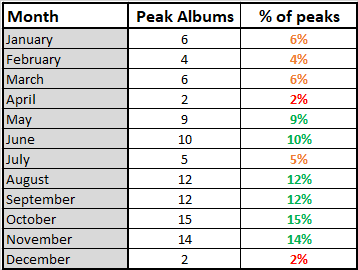
Among old legends, the one claiming you should release your album in November to sell well is deeply wrong too. Of course, one may say October/November appear to be the strongest months of the year as 29 out of the 97 peaks we store got issued in these months. There is simply much more releases at that period than in February or in July.
When we get into the details, the myth falls down even more as shown below.

Both Breakaway, Up All Night, Laundry Service and Come On Over got Xmas releases locally, but they were issued globally in softer months the following year. Saturday Night Fever, Let’s Talk About Love and The Bodyguard have all sold much more copies during the first quarter of the year following their release with the arrival of the related movie. Similarly, Enrique Iglesias, Like A Virgin, Thriller, M!ssundaztood and A Night at the Opera peaked in sales on their year 2. In other words: the November release isn’t responsible for their high sales at all.
With this in mind, why people do expect so much from Christmas releases? The first thing to remember is the nature of Christmas sales. In short, most of them are gifts for kids or moms. They do not reflect a ground-breaking hit that will stick on collective minds. Career highs are seen when artists flood radio stations’ playlists for various months. It’s almost impossible to do that at Christmas, the competition is just too strong.
Even if an album happens to sell well at Christmas time, labels will stop to invest on new singles since it did the job already. In the long run, this is a limitation more than an advantage. In November, you would better release a compilation. You can drop a new album if you are well past your peak and expect to sell it to your already built fanbase. In summary, the Christmas market is good to milk your catalog, but to improve it as peak albums do you need a lot of space on media.
Do you need ongoing momentum to hit your peak?
Relatively speaking…

This picture lists how much an album had to increase to reach the peak of its artist. For example, 5 albums outsold their predecessor by over 1000%. They are the biggest albums of Paul Simon, Pink Floyd, Cher, Bon Jovi and Green Day. These artists grew immensely in an unexpected way.
While the majority of peak albums at most tripled sales of their predecessor, we can see that plenty of them still posted increases of 300%, 500% or 1000%. A point often overlooked is that these predecessors have been fueled by the blockbuster which followed them. Thus, the true jump is even larger. These statistics prove that the magnitude of a smash isn’t limited to the appeal demonstrated with previous releases.
In absolute numbers…

This schema points out the sheer amount of sales achieved by predecessors of peak albums. We see that as many as 56 predecessors of top sellers out of 74 generated 5 million sales or more. Of course, here too we need to keep in mind they were boosted after the end of their own run. Only 5 predecessors remained under 2 million EAS.
Out of these, Kendrick Lamar, The Weeknd and the Arctic Monkeys are still building their catalog, there is no doubt they will cross this figure in the long run. The last two albums which preceded a career peak that sold so few are from Cher and Paul Simon. Ironically, their peaks are 2 of the 3 highest selling eras ever for artists over 40 years old. In other words, their blockbusters haven’t fueled their predecessors because they already had a healthy and diverse catalog. In most, people weren’t discovering them so they haven’t feel the need to complete their discography.
On the whole, it’s more peak albums which fueled past albums than past albums which paved the way to peaks. A last confirmation of this comes from this additional table. We can see that out of these 74 predecessors, as many as 24 were themselves down from their previous album. To sum up, there is no such thing as a momentum that prepares you for your peak.
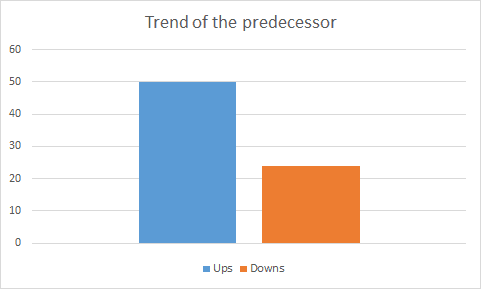
Splitting cases
Does gender impact results?

For this graphic, I separated bands and groups. Bands are defined as singers / songwriters / instruments players, a la Beatles and Pink Floyd. A group is a manufactured act like One Direction and N’Sync.
Results are striking. Females account for 20 of the 49 artists who peaked with their debut or their sophomore album. In the other side, there is more bands which peaked by their 5th album than by their first. As many as 5 groups out of 8 peaked with their debut.
After their 3rd album, only 37% of bands have peaked, but 60% of males, 74% of females and 100% of groups. Bands benefit from being less impacted by persona / image factors. They also enjoy creative inputs of several members instead of only one person. Males last longer because many of them are singer / songwriters while females are more short-lived. As for made-up groups, their appeal expires very fast.
During which era has it been the easiest to peak?
To analyze the impact of the era, we must first define these eras. It is tempting to go by decades, but they do not reflect market’s evolutions. We can distinguish 6 main period:
- Singles Era: from the earliest albums in our database to 1968. By then, singles were dominant and many artists were releasing albums and singles that were entirely independent.
- Albums Era: from 1969 to 1975. A short but buoyant period. LPs overtook singles. Major artists started to ignore in full the single format to sell exclusively albums.
- Blockbusters Era: from 1976 to 1987. Many more people had a record player. This increased dramatically the number of casual buyers and enabled the blockbusters phenomenon. Big albums from these years also got recycled in late 80s/early90s thanks to strong compilations.
- CD Era: from 1988 to 2002. The all-time peak period of the market. Albums from this era had one huge life, but most failed to transform into catalog strength due to the cherry-picking of iTunes.
- Digital Era: from 2003 to 2013. The iTunes era. Tracks are back in full force, easily dominating albums.
- Streaming Era: from 2014 to date. The general public translates fast from purchases to streaming subscriptions.
Now, let’s check how many artists peaked during each period.
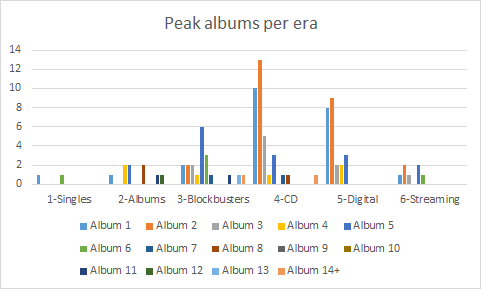
The absolute number of artists who peaked during each era obviously depends on who we studied. For instance, we dogged into many stars from the digital age. What’s visible though is that during the CD era, artists peaked fairly fast. In the other end, it was possible to register career highs almost at any time during the blockbusters years.
Another conclusion is that 100% of artists which peaked in digital or streaming era did it with one of their first 6 albums. What does it mean? It means that artists pre-dating these periods, who then released already 7 albums or more, aren’t able to do that well anymore.
Back then, the fact that albums were so expensive gave importance to consumers on their 40s and higher. Teenagers have always been more concerned by music than older people, but they had less money. With iTunes, they made a larger impact. With streams, your money wealth barely matters anymore. Furthermore, the more time you listen to music, the more you are relevant as a music consumer. That boosts the impact of the younger generation on charts and ultimately limits the appeal of new albums from older acts.
Do current artists peak earlier than past glories?

Truly fascinating. The majority (64%) of acts who debuted during the 60s peaked with their 6th album or later. On average, they peaked with their 9,71th album. It perfectly summarizes the league-axed industry of these days. An act had to prove his selling skills in his city first, then on his country, then on English-speaking markets and then globally. It was a long, steady climb to the top.
The process was similar but at a faster pace for 70s acts. It took 2-3 promising efforts until a label started to bet strong on you. The 80s saw the explosion of MTV and the arrival of Madonna. The first carefully manufactured and marketed pop stars appeared, trying to reproduce her success.
Out of the 59 acts we studied who debuted in 1989 or later, no one peaked with his 6th album or later. You have a few more words to guess who peaked the deepest into her career… That’s Taylor Swift, who peaked with her 5th record on her 8th year, with her LP ironically titled 1989. Statistics about acts who debuted in the 10s are still too fresh, since most of them issued only 1-3 records. Still, the fact that 74% of artists who debuted during the 00s peaked with one of their first two albums is very telling. You got it, the youngest you are, the fastest you turn has-been.
Valuing peaks
How good does your peak taste?
Below table displays the average number of sales achieved by the peak album of artists depending on their gender and their debut decade.

We can notice the overwhelming dominance of bands from the 60s to the 80s. On average, their albums peaked higher than peaks of anyone else at over 35 million. It’s due to their catalog appeal that opens the door to massive totals for classic albums. The average of males debuting during the 70s is inflated by Michael Jackson. Without him, the figure drops to 30,7 million. Male acts have been roughly consistent throughout the years.
To the surprise of nobody, females took over the lead since the 90s thanks to the Big 5 plus a few comets like Shania Twain. The ‘Rock is dead’ claim appears to be partially true as bands who debuted from the 90s to date have been peaking much lower than their fathers. As for groups, boys bands definitely had a golden period during the 90s. Their average for our current decade consists exclusively on One Direction, which make them look strong still. Truth is, apart from this later group, these kind of acts hasn’t been doing well lately.
You peaked, now what?

Various bands amassed immense sales during their career, so it’s no surprise to see them lead with albums following their peak in absolute terms. Statistics in percentage are enlightening though. We can see that groups are impressively healthy during 3 albums then freefall. It’s perfectly consistent with their careers, marketed to death over a short period of time to milk them while they are hot among teenagers. Then they disappear, or if lucky, some move into a solo career.
Bands have the weakest immediate post-peak album. It’s natural since their main classic album sells so well that the rest of their catalog can’t compete. In the long run though, they hold truly well. Males seem to remain popular after their peak for a long time. While it’s mostly true, it’s once again Michael Jackson who fuels albums peak +1/2/3 thanks to his Bad to HIStory albums.
Females are once again in-between groups and bands/males. They enjoy a hotter, more intense period around their peak. Then, in the mid to long run, they drop more. Basically, when groups last 3-4 years, divas tend to last 6 to 8 years. Males can remain strong for up to 15 years a la Eminem while bands are able to score hit albums for 20 years or more.
A concrete example of expectations
How can you exploit these numbers for your favorite artist? For example, Christina Aguilera is returning soon with a new album, Liberation. If we ignore Burlesque, that will be her 5th studio album since her peak, her self-titled debut. Female singers remain fairly stable between their albums Peak+4 and Peak+5. It’s also relatively true for bands and males. Thus, Liberation expected sales are just under those of Lotus.
Let’s try to be positive. Among the 39 Peak+5 albums we tracked, 13 posted increases over their predecessor, so Liberation has a 33% chance to top Lotus. Can we expect 2 million plus? Since her last album did just under a million, that would require a +100% increase in sales. No female artist ever did that with their 5th album post-peak. The biggest jump ever recorded by such an album is +55% by Britney Spears‘ Circus.
In this paragraph, I assumed that Liberation is the 5th album following her peak. How much are its chances to become itself her new peak? Well, virtually 0. Aguilera debuted 19 years ago. Among all artists we ever studied, the only singer to peak that deep into her career is Cher. She didn’t had that big of a peak previously and the market was perfect to enable a smash. The environment is nowhere near as favorable nowadays for Aguilera. Her peak is tough to beat in itself, that would require a Sheeranesque success. It will simply not happen.
Extra 1: Analysis of the Top 10 peaks ever
During these various pages, we saw that artists tend to peak fairly early in their career. We also saw that while it isn’t mandatory, it’s better if you are on a positive momentum. Does this apply to the very best selling albums of all-time?

Incredible! All biggest peaks ever were released at least 2 years into the artist’s career. On average, they were around for 5 years and a half. By the same token, the “Drops” column tells us that 9 out of these 10 artists had previously released at least 1 album that under-performed its immediate predecessor. The same 9 artists were already up to 4 albums or more! Also, all these albums posted an increase of at least 165% over their previous effort.
To sum up, these albums defy gravity. Their sales are already mind-blowing. The way they got there is also in complete opposition to conclusions we drew on remaining albums. While Led Zeppelin, Michael Jackson and Whitney Houston were referenced top sellers, there was nothing to suggest the subsequent 7 artists were going to be so massive with their following album.
Just like Amy Winehouse and Adele became juggernauts out of the blue, there is no rule which tells us who’s going to be the next big thing. Will it be Charlie Puth? SZA? Harry Styles? Only time will give us the answer!
Extra 2: Biggest female hit albums pre/post peak
I know a lot of you are mad about female singers. There is always heavy talks about who’s the most successful, who’s the biggest and who’s the most consistent. Here is a perspective never seen before. Below lists rank the most successful albums in relation to their timing versus the peak album of the artist. For example, the most successful female album that preceded the artist’s peak is Céline Dion‘s Falling Into You. The biggest album which immediately followed a career peak is True Blue by Madonna.
Biggest Pre-Peak female albums

Biggest Peak female albums
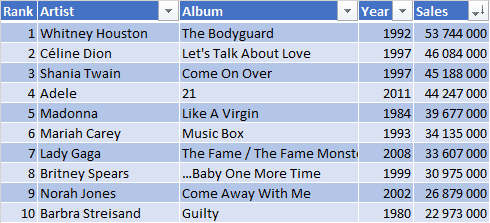
Biggest Peak+1 female albums
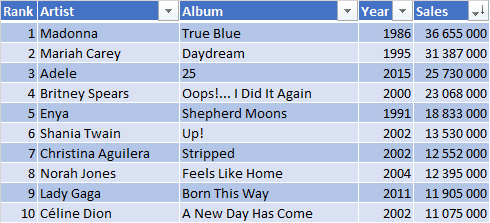
Biggest Peak+2 female albums
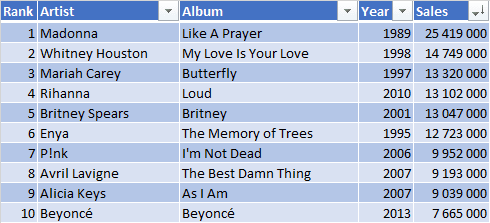
Biggest Peak+3 female albums
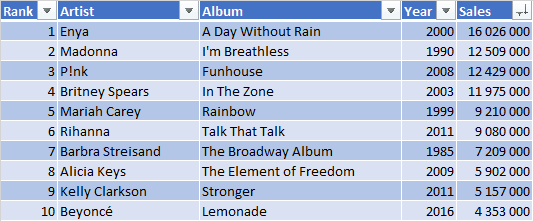
Biggest Peak+4 female albums

Biggest Peak+5 female albums
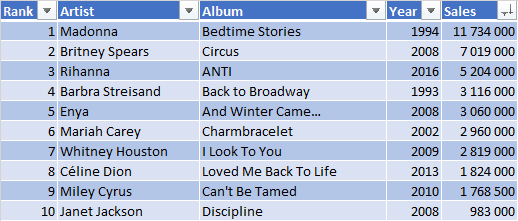
Biggest Peak+6 female albums

Biggest Peak+7 to Peak+13 female albums







